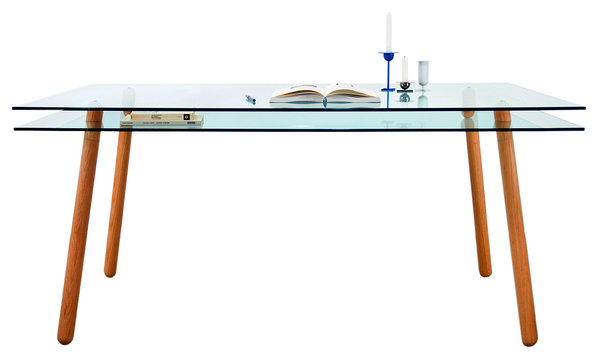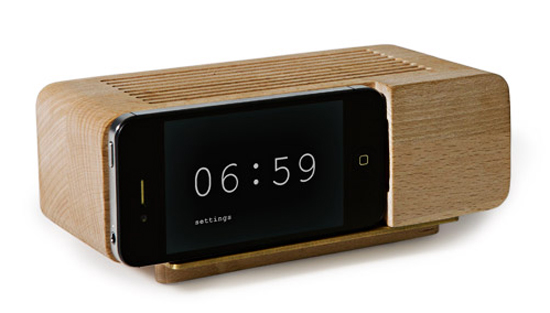 菲利普•斯达克(PHILIPPE STARCK)上周好像还忙着给法国Parrot公司介绍他设计的Zik无线耳机,然而,刚从巴黎飞回来的他似乎对设计的未来更有兴趣。身着黄色裤子和解开鞋带的白色运动鞋,他站在曼哈顿市一个装修精致的高级住宅里,欢快地对面前簇拥的人群作着演讲。
菲利普•斯达克(PHILIPPE STARCK)上周好像还忙着给法国Parrot公司介绍他设计的Zik无线耳机,然而,刚从巴黎飞回来的他似乎对设计的未来更有兴趣。身着黄色裤子和解开鞋带的白色运动鞋,他站在曼哈顿市一个装修精致的高级住宅里,欢快地对面前簇拥的人群作着演讲。
“设计的未来在哪里?”他反问,“设计就没有未来。当产品都变得仿生起来,最后就不存在产品了。”
斯达克说,数字时代开启了“非实物化”的年代,在这个年代,像Zik耳机这样的产品会更缩小和智能化。“这就是简到极致的魅力,”他说。
这样发展会是什么后果?他说,后果是我们都会被植入微芯片,然后变成产品。
当然,到那个阶段还需要一些时间。然而,在科技迅速地改变着我们生活的同时,家具行业依旧发展速度过慢,技术含量很低。在很多零售商那里,60年前设计的中世纪家具现在还被贴着“摩登”的标签。
尽管如此,近几年仍有一些家具设计师一直做着或大或小的努力,来适应新的科技形式以及iPad,电子阅读器和超薄、超平屏幕电视机这样的衍生产品。
在某种程度上讲,这其实也是他们别无他法的选择。
“科技演变的速度太快了,我们必须及时把这些变化通知到设计团队,”Ryan Anderson说道,他是赫曼米勒公司(Herman Miller)的未来技术总监。
在过去的几十年中,他补充道,设计师有时间去预测技术发展的方向,然后根据这个方向进行设计。然而,到了今天,“对空间和家具的把握必须在瞬间完成”。
赫曼米勒公司想到的方法之一就是尽量雇用Anderson这样的设计师。2个月之前,Anderson的这个职位还不存在。而现在,他就和设计团队一起为因特网时代出现的一些恼人问题寻找答案,例如,一旦iPad和平板电脑、笔记本等这些产品实现了工作地点的完全自由化,那么我们的办公室会变成什么样子?然而,人们更喜欢在工作场所还是沙发上使用这些产品,这个问题尚没有确切的答案,他说。
但是,从设计的角度出发,可以确定的一点是家具公司必须向前看。公司设计的家具产品不能停留已经过时的技术水平上,Gretchen Gscheidle说。她领导着赫曼米勒公司的产品发展,与Anderson的工作联系非常紧密。她还说,“我们必须让设计出来的产品跟上科技的步伐。”
许多公司对以上理念的理解仅存在于字面上,它们仅通过是否融合了苹果公司产品这个标准来评判市场上的新家具。比如,Hollandia公司生产的iCon床,在床头板上装有扬声器、一个放大器和可供放置两个iPad的坞口。再比如,Think Fabricate公司生产的一种抽屉,该公司标榜自己的产品有一个内置的充电设备,可以给电子产品进行充电。
这些混搭设计中被讨论得最多的要属Flos公司生产的一种台灯,这是一种装有使用苹果产品时所需坞口的台灯。Andrew Shabica是这个公司的一位产品经理,他介绍说这种产品将现代人眼中必不可少的iPad、iPhone与日常生活中经常使用的一个小物件,例如台灯,两者完美地结合在一起了。
斯达克先生也设计了一款台灯(但是他没有脱离现实世界),他的设计不仅尖端、前沿,而且有自己风格。Shabica先生说:“他不仅抓住了我们的想法,同时融入了几何、线条等元素,因此,他设计的不会只是一个简单的‘装有iPad坞口的沙发。’”
然而,一些设计师对这种混搭设计保持着谨慎的态度,原因很好理解——毕竟有内置八声道播放器的椅子曾经也是一种突破性的产品。
“科技变幻的速度太快了,过不了几年这种技术就会过时,” Edward Barber说,他是伦敦Barber Osgerby设计实验室的合伙人。“一旦充电坞口发生改变,这种台灯就显得多余了。”
因此,当CB2和M2L这些零售商不再仅靠把一些小部件拼凑在一起,而是更加注重家具的实用性,并适应人们在家使用家具的方式时,就不足为怪了。
例如,由荷兰设计师Gijs Papavoine为Montis公司设计,并在最近被M2L公司引进的Scene XXL椅子,就采用了附加桌子和后上方的软垫设计,这样就可以让用户在输入号码或打电话时的隐私受到保护。CB2公司引进的Tucker笔记本电脑桌打开时可以把笔记本或iPad存放到里面,并且当坐在沙发上时它的高度正好适合当一个办公台。同时,这家公司的Andes床有一个附加床头几,并把线路管理已经融入到设计中去了,这在几年前根本是没有听说过的。但就在今天,Ryan Turf,CB2公司的产品总经理说,“我们知道很多人晚上就寝前都要把iPhone放在床头充电。”
 正如赫曼米勒公司的Anderson所说,即使在Wi-Fi时代,线路管理仍是设计师最大的挑战。
正如赫曼米勒公司的Anderson所说,即使在Wi-Fi时代,线路管理仍是设计师最大的挑战。
“当看到一件精美的家具摆放在被堆满的各种电线破坏了美观的地方时,别提有多扫兴了,”他说。“把这些电线做成独立式非常重要”
信息技术可能没办法让这些电线隐形,但是正如Harry Allen,一位行业内部设计师多次提到的那样,“物质世界正在逐渐消失。”
你可以通过Dyvel桌子看到这一点。Dyvel桌子由玻璃和木头两种材料做成,外观非常漂亮,并且自带抽屉。你也可以通过超轻、超平屏幕电视和iPad这类产品看到这一点。这些产品虽具有娱乐功能,但却省略了这些功能所需的庞大组件。
“从设计的角度看”Allenx先生说,“有趣的是计算机摆脱了这么多的东西。我们不再需要闹钟了,因为手机上就有;我们不再需要文件柜了,因为手机上就有;很多以前占空间的东西,例如唱片和书,我们现在都可以不需要了。”
Allen先生最近为年龄在20岁的女士设计了两座公寓,这引发了人们的思考,“这些公寓里要摆放些什么呢?”最后,他把大部分空间都空了出来,因为他想以后可能会在这里放很多艺术品和个人手工艺品。
设计师Karim Rashid一直是这个行业的冠军人物,这是很有美感的一件事。很久以前,宜家曾宣布要把Billy书柜做得再深一些,因为很多人的书柜不只用来放书,几乎还要放所有其他东西。但Rashid先生却把家里的所有书柜都扔了,包括他的书、CD和DVD也一块儿扔了,以此表明自己为非实物时代到来所做的贡献。
在Rashid先生预想的世界里,所有家具“将开始与科技对话,并感受科技”,可以感知温度的装饰品不久后可能就会出现,在座椅中内置微型扬声器,嵌入液体水晶的壁纸能把墙壁变成一个巨大的电视显示屏。“那时候才是真正的实物隐形时代,”他说。
然而,“目前为止,发生的改变仍旧少得出奇,”他带着困惑说。“这正如内部环境往往是最后一个发生改变的一样。”
很多设计师发现他的观点虽然悲观,但的确如此。当问道哪种家具产品完美地融合了新科技时,Barber先生说,“亲爱的,我真的想不出一个来。”
家具行业的“新玩意儿”总是层出不穷,设计和品牌公司Fuseproject的创始人Yves Béhar说道,因此,我们的生活方式中到底发生了哪些重要转变不可能轻易说出——尤其是我们在人类工程学上的需求。
“坐在沙发上看电视和坐在沙发上敲电脑键盘” Béhar先生说,是两种不同的需要。“客厅设计自启用科技以来已有10至12年的历史,但我们现在摆在客厅中的家具竟没有丝毫变化。”
家具业巨头宜家的谨慎举措表明了问题所在。在宜家把家具设计融入最新科技之前,该公司的高级设计师Marcus Arvonen曾说,必须等到这种科技真正普及之后才能这么做。宜家可不想随便追随一种科技潮流之后,接着因为各种原因以失败告终。
“我们不会给一小部分早期需求者提供前沿方案,”Arvonen先生说,除非这是一个很大的市场。他补充道,宜家也是3年前才开始在自己的瑞典总部启用Wi-Fi的。
在理想世界中,科技将以更魔幻的方式融合于家居之中,Behar先生说,家居的核心部件将被模块化。换句话说,他说,“你可以把正在使用的沙发改装得适用于新科技。”
当那一天来临时,Béhar先生和其他人可能想要试验Jonas Damon的闹钟坞口装置。这个装置看起来就是一块设有坞口装置的木头,但是它却能把iPhone变为床头几上的闹钟。
是的,它很简单,看起来也比较复古。但是它同时阐明了一个新的真理:这个装置本身已经变成了一个家具。
 PHILIPPE STARCK was in town last week, ostensibly to introduce the Zik wireless headphones he designed for the French company Parrot. But Mr. Starck, who had just flown in from Paris, seemed more interested in holding forth on the future of design.
PHILIPPE STARCK was in town last week, ostensibly to introduce the Zik wireless headphones he designed for the French company Parrot. But Mr. Starck, who had just flown in from Paris, seemed more interested in holding forth on the future of design.
Dressed in yellow pants and unlaced white sneakers, he stood in a smartly furnished room of an upscale town house in Manhattan, jubilantly addressing a small crowd.
“What’s the future of design?” he asked rhetorically. “There is no future. When the product becomes bionic, in the end there is no product.”
The digital age, Mr. Starck said, has created a process of “dematerialization,” in which products like the Zik headphones are simultaneously shrinking and becoming smarter. “It’s the elegance of the minimum,” he said.
The end result? Eventually, he announced, we’ll all be implanted with microchips, and we’ll be the product.
Of course, that could take a while. As technology rapidly remakes most parts of our lives, the furniture industry remains largely slow-moving and low-tech. For many retailers, midcentury furniture designed 60 years ago still qualifies as “modern.”
Even so, in recent years a number of furniture designers have been struggling to adapt — in ways big and small, subtle and not so subtle — to new forms of technology and the proliferation of devices like the iPad, e-readers and ever-thinner flat-screen TVs.
In a way, they have no choice.
“The rate of technological change has gotten so fast that we need to inform the design to reflect it,” said Ryan Anderson, director of future technology for Herman Miller.
In decades past, he added, designers had time to anticipate where technology was headed and to plan for it. Today, he said, “the space and the furniture have to be cognizant” of it almost instantly.
One way that Herman Miller is trying to do that is by hiring someone like Mr. Anderson. Two months ago, his job didn’t exist. Now, he works with the design team to come up with answers to vexing Internet-age questions like what the home office should look like when the iPad and other tablets and laptops have freed us to work anywhere. It’s still unclear, he said, whether people prefer to use such devices on a work surface or, say, on the couch.
But what is clear from a design standpoint is that, going forward, the company’s furniture can’t layer on technology as an afterthought, said Gretchen Gscheidle, who leads product development at Herman Miller and works closely with Mr. Anderson. She added, “We need to have our products accommodate that technology.”
Many companies agree and are taking that idea literally, judging by all the new furnishings that incorporate Apple devices. Consider the iCon Bed from Hollandia, its headboard equipped with speakers, an amplifier and docking stations for two iPads. Or the Fleur de Noyer chest of drawers by Think Fabricate, which features what the company calls “Fleur de Tech” — a fancy way of saying it has a built-in charging station for electronic devices.
One of the most talked about of these mash-ups is the D’E-light by Flos, a sleek table lamp equipped with a dock for Apple devices. Andrew Shabica, a product manager for the company, said it made sense to take an everyday object like a lamp and combine it with the iPad or iPhone, “which has become a staple of our lives.”
Mr. Starck designed the lamp (he hasn’t abandoned the material world yet), and his involvement ensured not only a cutting-edge product but also one that was stylish too, Mr. Shabica said: “He can take our ideas and add geometry, lines. Rather than simply, ‘It’s a couch with an iPad docking station.’ ”
Some designers, however, are wary of this kind of mash-up, for obvious reasons. After all, the chair with the built-in eight-track player was once cutting edge, too.
“Technology moves at such a rate that it’s going to be redundant in a matter of years,” said Edward Barber, a co-founder of the London design studio Barber Osgerby. “As soon as the charging docks change, suddenly the lamp is redundant.”
So, it’s not surprising that retailers like CB2 and M2L are taking a more pragmatic approach, producing furniture that isn’t about incorporating gadgets, but rather about adapting to the way people use them at home.
The Scene XXL chair, designed by Gijs Papavoine for Montis and recently introduced by M2L, for example, comes with the option of an attached “tablet table” and an upholstered high back for privacy when typing or making phone calls. The Tucker laptop table from CB2 flips open to store a laptop or iPad inside and is low enough to use as a work surface while sitting on the couch. The company’s Andes bed has an attached nightstand with cord management built into the design, something unheard of a few years ago. But today, said Ryan Turf, CB2’s general merchandise manager, “we understand that a lot of people go to bed and put the iPhone next to their bed and still need to charge it.”
 And as Mr. Anderson of Herman Miller noted, even in the age of Wi-Fi, cord management is still one of the biggest challenges facing designers.
And as Mr. Anderson of Herman Miller noted, even in the age of Wi-Fi, cord management is still one of the biggest challenges facing designers.
“Seeing a beautiful piece of furniture in a beautiful space littered with cords and cables is not a great experience,” he said. “Making them discrete is important.”
IT may not be possible to make them disappear, but as Harry Allen, an industrial and interior designer, noted, in many ways, “the physical world is disappearing.”
You can see it in desks like the Dyvel Table, an elegant glass-and-wood piece that has done away with drawers altogether. Or in the way lightweight flat-screen TVs and iPods have all but eliminated the need for big entertainment units.
“What’s interesting, from a design standpoint,” Mr. Allen said, “is that the computer gets rid of so many things. You don’t need clocks because they’re on our phone. You don’t need file cabinets because they’re on our phone. A lot of things that used to take up room, like records and books, you don’t need.”
Mr. Allen recently designed two apartments for women in their 20s and recalled thinking, “What is this apartment going to be filled with?” In the end, he left the spaces largely empty, with the idea that they would eventually be filled with art and personal artifacts.
It’s an aesthetic that the industrial designer Karim Rashid has been championing for years. Long before Ikea announced that it was making its Billy bookcase deeper because so many people were using it to hold everything but books, Mr. Rashid ditched all the bookcases in his home, along with his books, CDs and DVDs, as part of his own effort to dematerialize.
Mr. Rashid envisions a world in which furnishings “will start speaking or feeling the technology,” and cites possible near-future advances like upholstery that reacts to temperature, tiny speakers built into seating, and wallpaper embedded with liquid crystals that turn a wall into a giant TV screen. “That’s the epitome of dematerializing,” he said.
Still, “it’s amazing how little there is out there,” he added with puzzlement. “It’s almost like the domestic environment is the last to change.”
Many designers find his assessment frustratingly accurate. Asked to name a product that perfectly fuses furniture with new technology, Mr. Barber said, “Honestly, I can’t think of one.”
While the furniture industry is good at thinking up new “trinkets,” observed Yves Béhar, founder of the design and branding firm Fuseproject, it has been slow to address essential changes in the way we live — in particular, our ergonomic needs.
“Sitting in my couch to watch TV versus sitting in a couch to type on my computer,” Mr. Béhar said, are two different needs. “We’ve had technology in our living rooms for 10 or 12 years, and furniture has not changed at all in response.”
The cautious approach taken by the furniture giant Ikea illustrates the problem. Before Ikea adapts its designs to reflect a trend in technology, said Marcus Arvonen, a senior designer for the company, the trend generally has to be very well established. The company doesn’t want to rush into a trend that doesn’t pan out, for one reason or another.
“We’re not doing frontier solutions for a small group of early adopters,” Mr. Arvonen said, but for a mass market. Ikea itself, he added, started using Wi-Fi in its Swedish headquarters only three years ago.
In an ideal world, technology would be integrated into homes in a more “magical” way, Mr. Behar suggested, in furniture with modularity at the core. In other words, he said, “you would be able to modify the couch that you’re using in a way that makes it adapt to new technologies.”
Until that happens, Mr. Béhar and others might want to check out Jonas Damon’s Alarm Dock for Areaware. Little more than a block of beechwood with a docking station, it turns an iPhone into a nightstand alarm clock.
Yes, it’s simple and retro-looking. But it also acknowledges a new truth: the device itself has become the furniture.
 菲利普•斯达克(PHILIPPE STARCK)上周好像还忙着给法国Parrot公司介绍他设计的Zik无线耳机,然而,刚从巴黎飞回来的他似乎对设计的未来更有兴趣。身着黄色裤子和解开鞋带的白色运动鞋,他站在曼哈顿市一个装修精致的高级住宅里,欢快地对面前簇拥的人群作着演讲。
菲利普•斯达克(PHILIPPE STARCK)上周好像还忙着给法国Parrot公司介绍他设计的Zik无线耳机,然而,刚从巴黎飞回来的他似乎对设计的未来更有兴趣。身着黄色裤子和解开鞋带的白色运动鞋,他站在曼哈顿市一个装修精致的高级住宅里,欢快地对面前簇拥的人群作着演讲。
 正如赫曼米勒公司的Anderson所说,即使在Wi-Fi时代,线路管理仍是设计师最大的挑战。
正如赫曼米勒公司的Anderson所说,即使在Wi-Fi时代,线路管理仍是设计师最大的挑战。

 PHILIPPE STARCK was in town last week, ostensibly to introduce the Zik wireless headphones he designed for the French company Parrot. But Mr. Starck, who had just flown in from Paris, seemed more interested in holding forth on the future of design.
PHILIPPE STARCK was in town last week, ostensibly to introduce the Zik wireless headphones he designed for the French company Parrot. But Mr. Starck, who had just flown in from Paris, seemed more interested in holding forth on the future of design.
 And as Mr. Anderson of Herman Miller noted, even in the age of Wi-Fi, cord management is still one of the biggest challenges facing designers.
And as Mr. Anderson of Herman Miller noted, even in the age of Wi-Fi, cord management is still one of the biggest challenges facing designers.